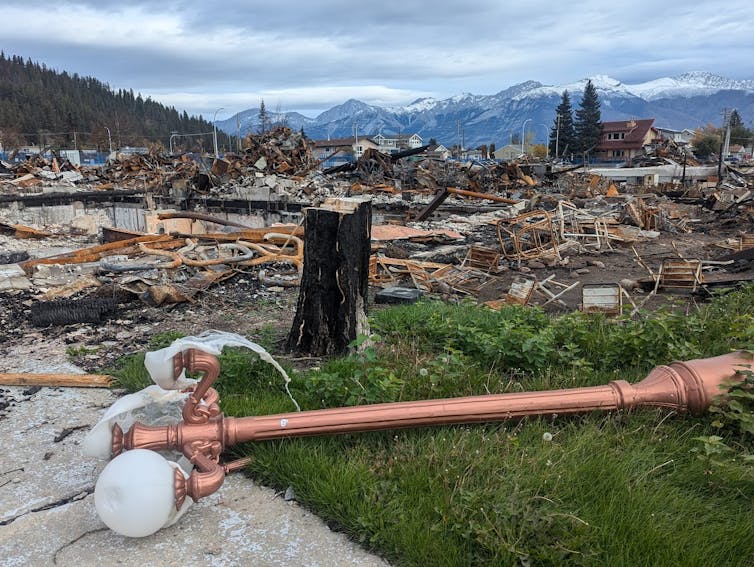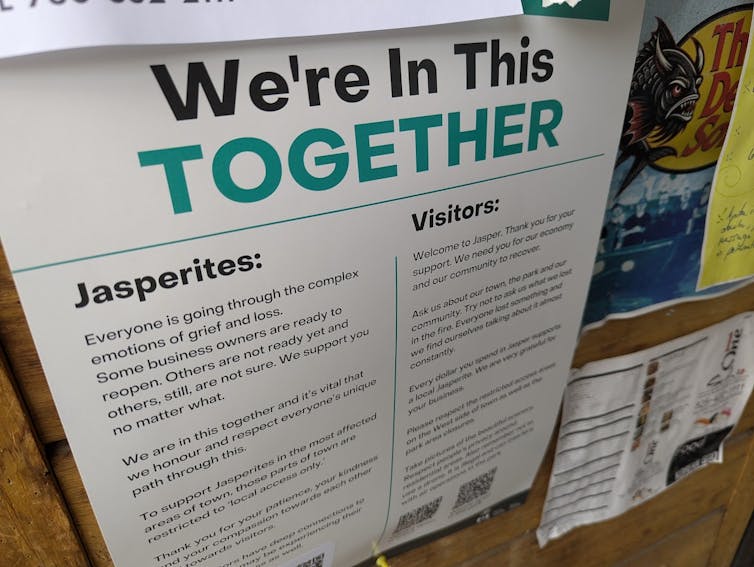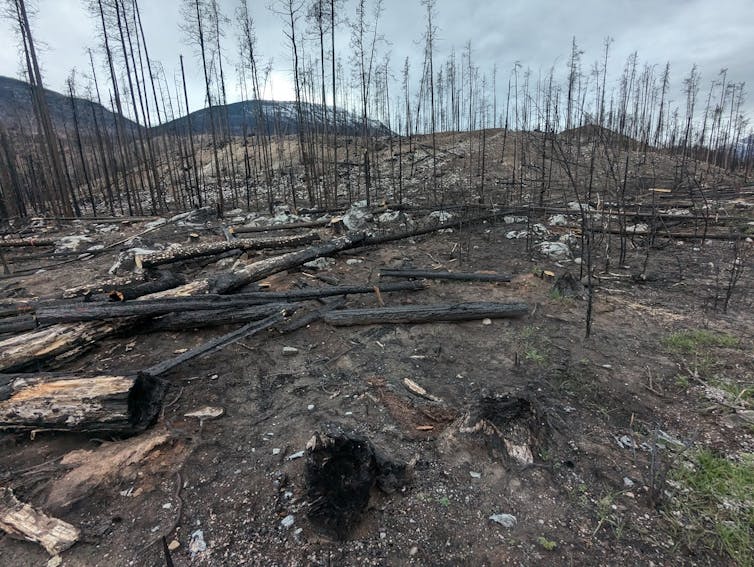On July 24, 2024, one-third of the structures in Jasper, Alta. were destroyed when the Jasper Complex Wildfire burnt an estimated 32,722 hectares.
As a researcher of disaster and emergency management, I visited Jasper in October to observe disaster recovery efforts there.
The Municipality of Jasper and its federal partners are actively managing the recovery. The municipality has submitted an application for $73.14 million in expenditures for reimbursement from Alberta’s provincial Disaster Recovery Program.
For those outside of the disaster zone, the message is that Jasper still exists and it is open for business. In the meantime, visitors need to be aware that residents are facing daunting tasks in a recovery effort that will take not months but years.
Visiting Jasper
As I approached Jasper from the south, through the fire-scarred Jasper National Park, I was first struck by what visually appears as a wasteland of burnt sticks in a black, brown and grey landscape.
(J. Rozdilsky), CC BY
Proceeding into Jasper, the landscape transforms into the disfigured skeletal remains of noncombustible portions of structures — the buildings have been reduced to piles of charred, rusting and decomposing objects in vast debris fields.
However, portions of Jasper’s built environment did survive the fire, and it is entirely possible to spend time in some parts of the town that remained intact rather than looking like a burnt-out war zone.
Clean-up challenges
A very visible and immediate challenge to Jasper’s practical recovery is the removal of debris.

(J. Rozdilsky), CC BY
Work is underway to expedite bulk debris removal action. The action would work by removing debris across multiple properties at the same time by using one contractor.
One of the challenges of removing the debris is the rapid approach of winter. November sees the most snowfall in Jasper, with an average snowfall of 135 millimetres.
Despite best efforts being made, if large tracts of disaster debris become frozen in place over winter, such a situation will impede recovery progress in 2025.
In addition to health hazards and special worker safety related to fire debris, improper management of disaster debris can impede the timely recovery of the affected area.
Land classification
Less visible, but nonetheless important, challenges facing disaster recovery in Jasper are unfolding policy dilemmas related to a very nuanced land tenure situation. Rules of land tenure define how access is granted to rights to use, control and transfer land, as well as associated responsibilities and restraints.
From the public administrative perspective, Jasper is not your typical Canadian town. It is formally a provincially classified specialized municipality that exists within the boundaries of federally administered national park lands governed under the National Parks Act.
The situation means disaster recovery will take place under a unique set of rules governing everything from land use decisions to one’s right to reside in Jasper. In Jasper, residents own their homes, but not the property they sit on; the Crown is the only landowner in the park.
Until an amendment to the Canada Parks Act known as Bill C-76 received royal assent on Oct. 3, 2024, Jasper’s local government did not have the ability to exercise control over its own land use and planning. Under Bill C-76, the Municipality of Jasper will formally take authority over specific elements of land-use planning and development that were previously held by Parks Canada.
However, this nuanced land tenure situation in Jasper will complicate recovery. Unanticipated consequences of overlapping interests will occur as several parties in Jasper are allocated different rights to the same parcel of land.
Collective recovery
A sign that Jasper was moving in the right direction was evidenced by a municipally based public information campaign consisting of posters in the town centre. The headline on the poster was “We’re in this together.”

(J. Rozdilsky), CC BY
The left column of the poster addresses Jasper residents, while the righthand side speaks directly to visitors. Visitors were advised to “ask us about our town, the park and our community. Try not to ask us what we lost in the fire.”
The “We’re in this together” theme related to recovery applies beyond local affairs. For those far outside of Jasper, now is the time to support the town’s unique role as a national asset, facilitating access of 2.5 million visitors yearly to Canadian natural areas.
For Jasper’s disaster recovery, we are indeed all in this together.




